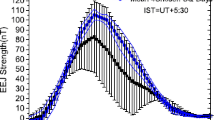Abstract
There are numerous geomagnetic indices used in monitoring various magnetospheric and ionospheric phenomena. Some of the most widely used indices are the ap, AE and Dst. In this work, the relationship between these three geomagnetic indices is investigated at different levels of solar and magnetic activity. 3-h average data spanning 8-years were used—high (HSA), moderate (MSA) and low solar activity (LSA) periods cover the years 1999–2001, 2004–2005, and 2006, 2009–2010 respectively. All the investigated correlation pairs recorded the highest/lowest during the LSA/HSA periods. The ap/AE correlation was found to be highest ranging within 70–78 % at any solar activity. The ap versus AE and Dst multiple correlation reached 94.0, 92.1, and 89.2 % for HSA, MSA, and LSA conditions, respectively, and 72.1, 83.3, and 80.0 % for the main phase, recovery phase and quiet conditions respectively. Moreover, higher percentage correlations were observed for the ap/AE pair at any geomagnetic conditions than for the ap/Dst and AE/Dst pairs. The ring current index Dst is observed to have a greater influence on ap during geomagnetic storm periods.








Similar content being viewed by others
References
Adebesin BO (2008) Roles of Interplanetary and Geomagnetic parameters in ‘intense’ and ‘very intense’ magnetic storms generation and their geoeffectiveness. Acta Geod et Geophys Hung 43(4):383–408. doi:10.1556/AGeod.43.2008.4.2
Adebesin BO, Chukwuma VU (2008) On the variation between Dst and IMF Bz during ‘intense’ and ‘very intense’ geomagnetic storms. Acta Geod et Geophys Hung, 43(1):1–15. doi:10.1556/AGeod.43.2008.1.1. ISSN 1217-8977
Adebesin BO, Adeniyi JO, Adimula IA, Reinisch BW, Yumoto K (2013a) F2 layer characteristics and electrojet strength over an equatorial station. Adv Space Res 52(5):791–800. doi:10.1016/j.asr2013.05.025
Adebesin BO, Ikubanni SO, Adebiyi JS, Joshua BW (2013b) Multi-station observation of ionospheric magnetic disturbance of March 9 2012 and comparison with IRI model. Adv Space Res 52(4):604–613. doi:10.1016/j.asr2013.05.002
Adebesin BO, Adeniyi JO, Adimula IA, Reinisch BW (2013c) Equatorial vertical plasma drift velocities and electron densities inferred from ground-based ionosonde measurements during low solar activity. J Atmos Solar Terr Phys 97:58–64. doi:10.1016/j.jastp.2013.02.010
Adebesin BO, Adekoya BJ, Ikubanni SO, Adebiyi SJ, Adebesin OA, Joshua BW, Olonade KO (2014) Ionospheric foF2 morphology and response of F2 layer height over Jicamarca during different solar epochs and comparison with IRI-2012 model. J Earth Syst Sci 123(4):751–765. doi:10.1007/s12040-014-0435-y
Amory-Mazaudier C (2009) Electric current systems in the earth’s environment. Niger J Space Res 8:178–255
Cade WB, Sojka JJ, Zhu L (1995) A correlative comparison of the ring current and auroral electrojects using geomagnetic indices. J Geophys Res 100:97–105
Cortie AL (1912) Sunspots and terrestrial magnetic phenomena, 1898–1911. Mon Not R Astron Soc 73:52–60
Fares Saba MM, Gonzalez WD, Clua de Gonzalez AL (1997) Relationships between the AE, ap and Dst indices near solar minimum (1974) and at solar maximum (1979). Ann Geophys 15:1265–1270
Grimald SR (2013) A comparative study of Kp, Ap, Km, Am, Dst and AE index. Geophys Res Abstr 15:5316
Gulyaeva TL (1993) Indices of geomagnetic variations and ionospheric disturbances. Adv Space Res 13(3):21–31. doi:10.1016/0273-1177(93)90243-5
Häkkinen LVT, Pulkkinen TI, Pirjola RJ, Nevanlinna H, Tanskanen EI, Turner NE (2003) Seasonal and diurnal variation of geomagnetic activity: revised Dst versus external drivers. J Geophys Res A 108(A2):1060. doi:10.1029/2002JA009428
Hanslmeier A (2007) The Sun and space weather. Astrophysics and space science library, 2nd edn. Springer, Netherland, p 191. doi:10.1007/978-1-4020-5604-8
Kamide Y (1988) Electrodynamical processes in the Earth’s ionosphere and magnetosphere. Kyoto Sangyo University Press, Kyoto
Le Mouël J-L, Blanter E, Shnirman M, Courtillot V (2012) On secular changes of correlation between geomagnetic indices and variations in solar activity. J Geophys Res 117:A09103. doi:10.1029/2012JA017643
Loewe CA, Prolss GW (1997) Classification and mean behavior of magnetic storms. J Geophys Res 102:14209
Love JJ, Remick KJ (2007) Magnetic indices. In: Encyclopedia of geomagnetism and paleomagnetism. Springer, Dordrecht, pp 509–512. http://geomag.usgs.gov/downloads/publications/Magnetic_Indices.pdf
Mayaud PN (1980) Derivation, meaning and use of geomagnetic indices. Geophysical monograph 22. American Geophysical Union, Washington, DC
McIntosh D (1959) On annual variation of magnetic disturbance. R Soc Lond 251:525–552
Menvielle M, Berthelier A (1991) K-derived planetary indices: description and availability. Rev Geophys 29(3):415–432
Pietrella M (2012) A short-term ionospheric forecasting empirical regional model (IFERM) to predict the critical frequency of the F2 layer during moderate, disturbed, and very disturbed geomagnetic conditions over the European area. Ann Geophys 30:343–355. doi:10.5194/angeo-30-343-2012
Pietrella M, Perrone L (2008) A local ionospheric model for forecasting the critical frequency of the F2 layer during disturbed geomagnetic and ionospheric conditions. Ann Geophys 26:323–334
Richmond AD, Maute A (2014) Ionospheric electrodynamics modeling. In: Huba J, Schunk R, Khazanov G (eds) Modeling the ionosphere-thermosphere system. Wiley, Chichester, pp 57–71. doi:10.1002/9781118704417.ch6
Rostoker G (1972) Geomagnetic indices. Rev Geophys Space Phys 10:157
Rostoker G (1991) A quantitative relationship between AE and Kp. J Geophys Res 96:5853–5857
Russell CT, McPherron RL (1973) Semi-annual variation of geomagnetic activity. J Geophys Res 78:92–108
Saba M, Gonzalez WD, Gonzalez ALC (1994) Relationship between the Dst, ap and AE indices. Adv Space Res 14:435–438
Yamazaki Y, Kosch MJ (2014) Geomagnetic lunar and solar daily variations during the last 100 years. J Geophys Res Space Phys 119:6732–6744. doi:10.1002/2014JA020203
Acknowledgments
The author is grateful to the National Space Science Data Center (NSSDC) through the OMNIWEB database (http://nssdc.gsfc.nasa.gov/omniweb) for the hourly data of the magnetic indices used. I will like to thank the three reviewers for their positive criticism and suggestions, which had improved the quality and structure of the paper.
Author information
Authors and Affiliations
Corresponding author
Rights and permissions
About this article
Cite this article
Adebesin, B.O. Investigation into the linear relationship between the AE, Dst and ap indices during different magnetic and solar activity conditions. Acta Geod Geophys 51, 315–331 (2016). https://doi.org/10.1007/s40328-015-0128-2
Received:
Accepted:
Published:
Issue Date:
DOI: https://doi.org/10.1007/s40328-015-0128-2




